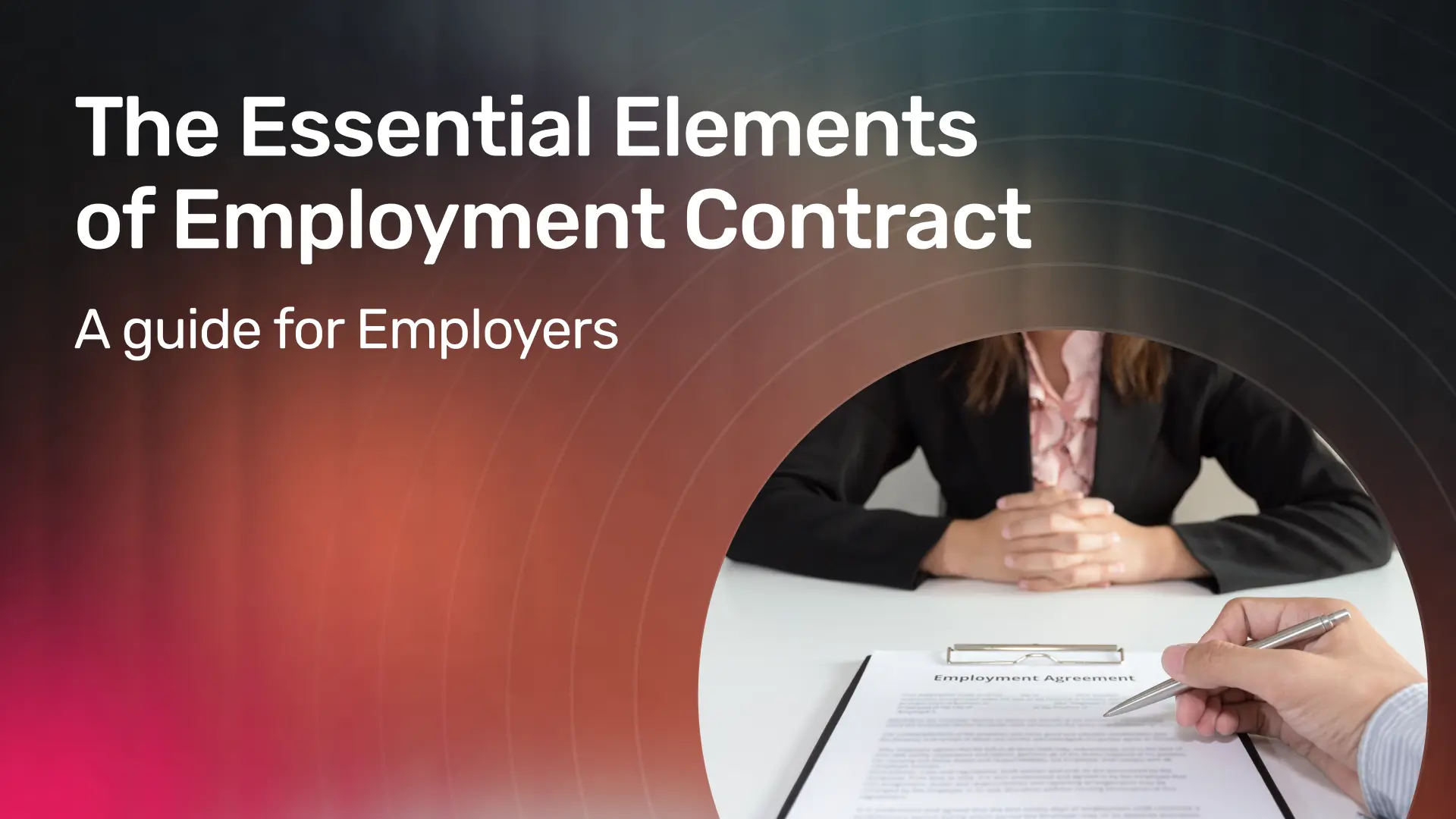The Essential Elements of an Employment Contract: A Guide for Employers
When hiring a new employee, there’s one key document that you need to provide before they start working - the employment contract. This document is beyond just a formality. On the contrary, it’s the basis of every employment relationship that helps establish the most important terms, protects both you and the employee, and ensures compliance with labour laws.
But what exactly should be included in an employment contract, and how can you make sure it covers everything necessary? Keep reading, as in this guide, we’ll break down the most important elements to help you create fair, transparent, and legally sound contracts.

What is an employment contract?
In simple terms, an employment contract is a formal agreement between an employer and an employee that outlines the terms of their working relationship. It covers details like job responsibilities, salary, benefits, termination conditions, and more, to protect both parties under labour laws.
With the different types of employment contracts, role requirements, and local labour laws, the specifics of the agreement can be different. That’s why it’s important to draft contracts that align with both legal requirements and the needs of your business and your new employees.

Why is it important to have an employment contract?
Having a clear and well-structured employment contract is essential for any business. Employment contracts set the foundation for any professional relationship, serve as a legal safeguard, and provide the necessary clarity on the most important terms. Let’s explore in more detail why employment contracts are important.
It helps you comply with employment laws
Every country has its own labour laws that define hiring, wages, working conditions, and employer/employee rights. With an employment contract, you ensure that your business stays compliant with these regulations by defining terms such as salaries, working hours, overtime policies, and similar.
Without a legally sound contract, you risk fines, legal actions, or even disputes that can potentially harm your company’s reputation and financial stability.
It protects and provides clarity for both parties
An employment contract safeguards the interests and rights of both parties. Employers can use it to outline confidentiality clauses, non-compete agreements, or intellectual property rights to protect their interests and secure their business. At the same time, employees are assured of their rights regarding job security, compensation, benefits, and working conditions.
With contracts clearly defining the employment terms, they also help avoid confusion. Employees understand what they are entitled to, while employers have a legal framework to follow regarding compensation structures, benefits, and other important terms.
It serves as a guide and evidence in case of a dispute
Workplace disagreements can happen, whether about salary, expectations, or job termination. When an employment contract is in place, it can be used as a written reference point that both parties can rely on in cases of issues.
If a dispute escalates to legal action, the contract provides documented proof of the agreed-upon terms and helps resolve the conflict quickly. Without a contract, it can be difficult to prove what was initially agreed, leaving room for more misinterpretation or unfair claims.

Key elements of an employment contract
The elements included in an employment contract will mainly depend on the type of contract, the type of role, and the labour laws of the country of employment. Below, we explore some of the most common elements that can be found in almost every contract.
Identification of parties
The identification of the parties involved is a basic, but a very important element of the contract, as it specifies the employer’s and the employee’s full legal names, addresses, and other details. This section ensures that there’s no confusion about who is entering the agreement.
For the company, the identification should include the legal name of the organisation, business registration details, and the relevant representatives who are authorised to sign the contract on behalf of the company. On the employee’s side, the most important details include the full name and their position.
Job title and description
A clear job title is essential to help both parties understand the role and the expectations. However, a job title alone doesn’t give the full picture, so it’s also important to include a job description that defines the employee’s duties and responsibilities.
More specifically, this section defines what tasks the employee is expected to perform, including daily tasks, project-specific duties, and their performance metrics. Hence, the job description is important not only for setting expectations but also for avoiding misunderstandings about the scope of work.
Compensation and benefits
This section outlines the employee’s salary or wage, how often they will be paid (weekly, bi-weekly, or monthly), and whether the payment will be made via a direct deposit, a payment platform, or another method. Beyond the salary base, it also includes any bonuses, commissions, or performance incentives that might apply.
The benefits package part details any health insurance, retirement savings, life insurance, or other perks provided by the employer. The goal is to make sure that the employees know exactly what they’re being compensated for and what additional benefits they can access, which creates better transparency and avoids potential disputes about pay or perks.

Term of employment
The term of employment defines whether the employment is permanent, temporary, or contract-based. This section is essential for outlining the duration of employment, and it can help the employer and the employee manage their expectations.
Hence, in the case of fixed-term employment, this section should define the start and end dates of the contract. On the other hand, if it’s an indefinite-term contract, it should define the notice period. For temporary employment contracts, this section should outline the conditions for renewal, extension, or end of the contract.
Working hours and location
This section of the contract provides details about the expected working hours, the number of hours per week, and the specific start and end dates of the working day. It should also address whether the role is full-time, part-time, or flexible and if there’s room for overtime.
The location of the work should also be specified here, no matter whether the job is at a company office, remotely, or involves travel. For remote workers, this section must clarify expectations regarding virtual communication, attendance at meetings, and availability across time zones.
Probationary period (if applicable)
A probationary period allows both the employee and the employer to assess whether the working relationship is a good fit for both parties. Hence, this section should outline the duration of the probationary period, which is typically 3 to 6 months, any performance evaluations that will occur during that time, and the eligibility for employee benefits.
Additionally, it should state the terms under which the contract can be terminated during this period, including the required notice period. If the probationary period is successfully completed, the employee may transition to a permanent employment status, which must also be defined in this section.
Leave policies
This section should outline all the types of leave the employee is entitled to, such as paid vacation, sick leave, maternity/paternity leave, public holidays, flexible time-off options, and others. It specifies how many days of leave the employee is entitled to each year, whether unused leave rolls over and any specific conditions for taking leave (such as advance notice and similar).
Including a detailed leave policy will prevent any confusion and ensure that your new employee knows their rights regarding time off and everything else they need to be aware of when they are absent from work.
Confidentiality and intellectual property
Maintaining confidentiality about sensitive information, business strategies, and client data is of utmost importance for many businesses. Hence, it’s necessary to include confidentiality clauses to make sure that employees understand their obligations of keeping proprietary information confidential, both during and after their employment.
Intellectual property clauses are also essential for employees whose work includes creating inventions, content, or other types of innovation. These clauses protect the employer’s interests by stating that any work-related IP (such as software, designs, and patents) created during employment remains the property of the company, not the employee.
Termination clause
The termination clause outlines the conditions under which either party may terminate the employment contract. It includes the notice period, the steps to be followed for a resignation or termination, and the reasons for termination, such as performance issues or misconduct. In addition, this clause should also specify whether the employee will receive severance pay and whether a non-compete agreement is in place.
This part of the contract needs to ensure that both parties are aware of their rights and responsibilities if the employment relationship comes to an end, whether it’s voluntarily or involuntarily.
Dispute resolution
No matter how carefully contracts are written, disagreements can easily arise at any time. So, including a dispute resolution clause helps determine how conflicts should be handled before they escalate into lengthy legal battles.
This clause might specify a process for mediation or arbitration, which is often faster and more cost-effective than going to court. The dispute resolution section should provide clarity on what steps will be taken in case of a disagreement and help both parties avoid unnecessary stress and expenses.
Signatures
The signature section is where both parties formally agree to the terms of the employment contract. By signing the contract, both parties acknowledge that they understand the terms outlined and that they agree to abide by them.
Therefore, it’s important that this section includes spaces for both parties to sign, along with the date of agreement, to confirm the mutual consent. Without signatures, the contract will lack legal validity and won’t provide the necessary protection for both the employer and the employee.

Generate compliant employment contracts with Native Teams
Creating an employment contract that complies with all the legal requirements can be complex, especially when hiring team members across multiple countries worldwide. The Native Teams platform lets you delegate this overwhelming task to experts and provide fully compliant employment contracts in 85+ countries around the world.
Whether you’re working with full-time employees, freelancers, or contractors, our platform makes it simple for you to generate contracts that follow each individual’s local labour laws. With the help of our simplified tools and our professional team's support, you can ensure that your business remains on the right side of the law without any worries about keeping up with the changing local regulations and other legal details.
Explore Native Teams' employment contract templates, or book a free demo call to learn more about how we can help you stay compliant with each employee’s local labour laws.
Summing up
Having a well-drafted employment contract is essential for both employers and employees to set clear expectations, provide legal protection, and ensure that both parties are aligned on the terms of the working relationship. No matter whether you’re hiring locally or globally, an employment contract will help you minimise the legal risks and keep everything transparent.
By taking the time to create a comprehensive, compliant contract, you lay the foundation for a smooth working relationship without any legal issues.
